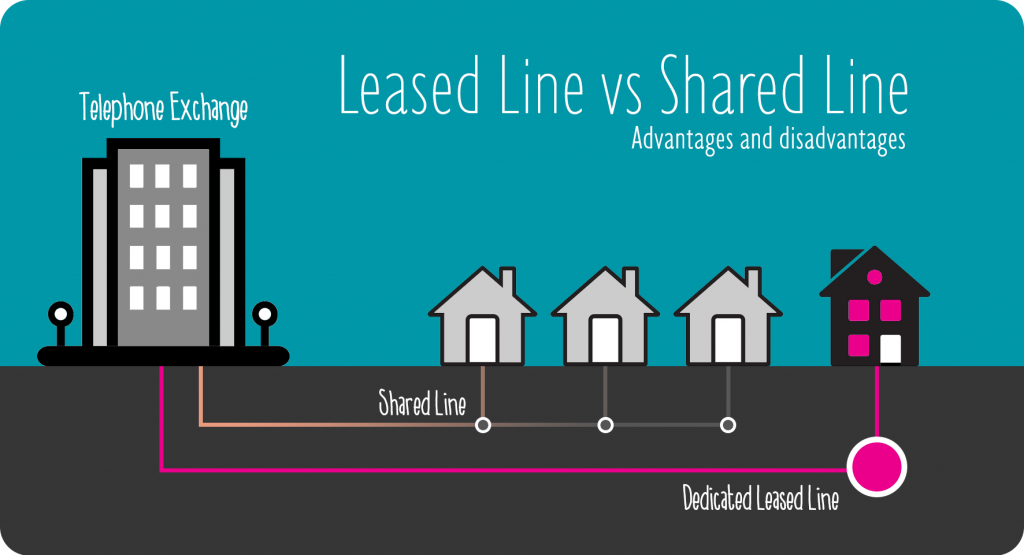In simple terms, a leased line is an exclusive form of data connection. It is referred to as “leased” as there is a monthly rate for renting a leased line.
Depending on your situation, a leased line can be an ideal and high-performing alternative method for data connectivity, especially in a larger business that wishes to connect offices together (MPLS) and achieve higher speeds and reliability.
What is a leased line?
A leased line is a symmetric circuit, meaning you can send or receive data quickly from one location to another (this can include multiple locations).
With a leased line, there is a dedicated connection which results in not having to share the bandwidth with anyone else; it’s “dedicated” to your constant use, at any given time!
Essentially, your connection is not shared so speeds will not be impacted during peak times when others are using the same ISP (Internet Service Provider) to full capacity.

What is the difference between leased line and a standard broadband connection?
Standard broadband such as ADSL (asymmetric digital subscriber line) or FTTC (fibre to the cabinet) are typical choices of connection in homes and SME. They offer a fixed, reliable mode of connection, provided over home telecommunication lines. However, the rate of connection can be impeded by the distance from the house location to the local telephone exchange.
In comparison to standard broadband, leased lines often have faster upload speeds as there is a 1:1 connection ratio. Reserving a circuit through a leased line means you do not have to contend with congestion during peak times.
Users with the same service provider share the bandwidth with other customers on standard broadband, whilst the circuit on a leased line is exclusively reserved.
Why use a leased line service?
There are various reasons to implement leased lines, particularly in an established business environment. They are predominantly used to link two locations together and improve efficiency over a company’s shared network, not only in terms of internet access, but for telephone purposes too. A corporation may have two offices which need linking or they may need to connect to their data centre to increase efficiency and speed.
Businesses tend to use leased lines for:
- High speed connections for head offices carrying phone calls (VoIP)
- Improving 24-hour internet service, especially at peak times
- Ensuring staff can access work computers from home
- SLA’s
Advantages of using a leased line
Reliable service
One of the key benefits of using a leased line is the fact that it is dedicated rather than shared. This results in reliable and secure connectivity which does not fluctuate or lull in busy usage periods.
Connection support
Unlike leased lines, most broadband solutions do not offer SLA (service level agreements). At Structured Communications, all fibre leased lines are fully managed by experienced engineers within the premium SLA and guaranteed fix time. This means that any connectivity issues will be a priority and resolved promptly.
Higher symmetric speeds
Leased lines frequently provide quicker upload and download speeds compared to alternative connection methods, as they are symmetric and dedicated. This works in your favour when staff are consistently telephoning, backing up data, sending larger files or uploading web pages regularly.
Often with leased lines, there is unlimited usage on both downloads and uploads whilst speeds are steadier.
Business flexibility
In a world which is rapidly increasing its data consumption, a leased line is scalable, adaptable and easier to manage. You can grow your data usage in correlation with your business requirements.
Disadvantages of using a leased line
Additional expense
Although pricing has decreased over time, the cost of installation, combined with the ongoing monthly rental fees of a leased line, remain significantly higher than that of other connection alternatives, such as ADSL or FTTC. It can be an expensive form of data connectivity.
Longer set-up
When installing a leased line, it can be a lengthier process.
Firstly, the waiting time for a quote can be prolonged as a communications company should want to assess what best suits your specific requirements.
The physical installation process can be complex as it involves creating a new circuit and therefore some possible building work in different locations. Installing an ADSL or FTTC broadband typically takes up to three weeks as there is already an existing network in the area whereas a leased line can take around three months to put in place.
Do I need a leased line?
Clearly, for residential purposes, a leased line is not particularly appropriate (unless you have lots of money to spend).
However, you might want to consider leasing a line if high-quality connectivity is essential to running your business.
You should think about opting for a leased line if:
- Your business operates in a large office space with many staff
- Your business needs linking to other office locations or databases
- You operate a large-scale website/s
- Use of online services such as Office 365 or google drive
- You require secure and ongoing internet connectivity for many people at once
- You make frequent use of phones (VoIP)
- You constantly transfer large files and amounts of data
If you want to find out more, Structured Communications can deliver honest expertise and solve your connectivity solutions by providing quality advice and support.


